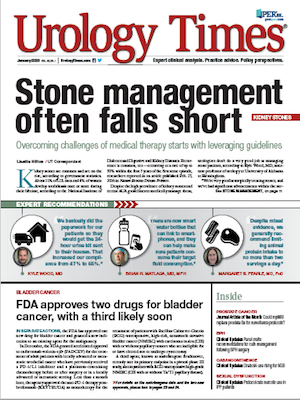Publication
Article
Urology Times Journal
OnabotA use on the rise for neurogenic bladder
Author(s):
“Although the raw number of augmentations and diversions have been relatively unchanged, the proportion of patients undergoing both surgeries declined while the proportion of patients undergoing Botox injections doubled over the past 5 years,” said Rita P. Jen, MD, MPH.
Rates of bladder augmentation and incontinent diversions have declined dramatically in recent years, corresponding to an increasing use of onabotulinum toxin A (onabotA [Botox]) for patients with neurogenic bladder (NGB), researchers reported.
“Although the raw number of augmentations and diversions have been relatively unchanged, the proportion of patients undergoing both surgeries declined while the proportion of patients undergoing Botox injections doubled over the past 5 years,” said Rita P. Jen, MD, MPH, chief resident in urology at the University of Michigan in Ann Arbor. She presented results of a study conducted under senior author J. Quentin Clemens, MD, at the 2019 AUA annual meeting in Chicago.
Read: Pain-focused stone patients less likely to reach treatment goals
The authors compared rates of the two surgical procedures and onabotA usage at a single institution over the past 11 years. OnabotA was approved by the FDA in 2011 for the treatment of urinary incontinence due to detrusor overactivity associated with a neurologic condition.
The study included a total of 3,303 patients encompassing 9,867 patient visits for neurogenic bladder. Of those, a total of 86 patients underwent incontinent urinary diversion, and 70 patients underwent augmentation; among those patients who underwent the surgical procedures, spinal cord injury was the most common etiology for neurogenic bladder, followed by myelomeningocele, multiple sclerosis, and others. A total of 968 patients underwent onabotA injection; there were 32 patients with failed injections who then underwent either of the surgical procedures.
Substantial rise in onabotA injections seen
Over the study period ranging from 2007 to 2017, the number of bladder augmentations and incontinent diversions remained relatively stable, while onabotA injections rose substantially. The stability of the rates of surgical procedures, though, was related to a rise in total patient encounters.
After an adjustment for all patients with a neurogenic bladder diagnosis, the proportion of augmentation procedures per year decreased from 1.94% in the period including 2007 through 2009 (24 of 1,238 patients) to 0.73% from 2015 through 2017 (15 of 2,044 patients). The odds ratio for the procedure’s use in the later period compared to the earlier was 0.37 (95% CI [0.20, 0.72]; p<.003). The same was true for incontinent diversions, which decreased from 1.86% in the earlier period (23 of 1,238 patients) to 1.03% in the later period (21 of 2,044 patients), for an OR of 0.55 (95% CI [0.30, 0.995]; p=.048).
Also see: Oral advanced prostate cancer agent shows safety, efficacy
Meanwhile, the use of onabotA rose sharply as a proportion of patient encounters. In 2012, the rate of use was 10.46% (55 of 526 patients), compared with 21.92% in 2017 (217 of 990 patients), for an OR of 2.40 (95% CI [1.75, 3.30]; p<.001).
The use of onabotA as a primary option was further illustrated by an increase in the number of patients with failed onabotA prior to surgery as time went on. In the 2007-2009 period, 10.6% of surgical patients had a prior failed injection, compared with 47.2% in the 2015-2017 period (p<.001).
The authors noted that these changes in the rate of onabotA use do suggest a shift in the management of patients with neurogenic bladder.
“We need more data to determine if Botox is a durable management option for patients with a neurogenic bladder,” Dr. Jen said.
Tell us what you think! Email comments to urology_times@mmhgroup.com

Newsletter
Stay current with the latest urology news and practice-changing insights — sign up now for the essential updates every urologist needs.






























